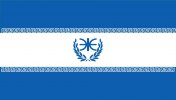"and before this battle was over, even a god-king can bleed" - Leonidas, 300

The flag of the Human Union of Earth and Narmer's Four Stars (usually shortened to the Four Stars) . the black and white section evokes the flag of the Narmerian Imperium, Narmer's head represents him as the chief deity of the Four Stars, and the four sun astronomical symbols represent the Sun, Alpha Centauri A/B, and Proxima Centauri. The green represents the lushness of Earth.

The flag of the Alarian Imperium is orange to symbolize the battle over Alaria that was the first major victory against the stellarborne. The yellow star represents Alaria being founded by the Terran Refugees, while the white star represents Alaria having been the capital world of the Narmerian Imperium. The black shield represents the defense of their culture and citizens against the new unstable galaxy.
"The Imperium collapsed and our reborn Earth fell under control of those who only want to parade it as a trophy. Humanity once stood as the rulers of the galaxy, now we are just like all the other species, warring for the remnants and hoping peace will eventually form once again" - Unknown
The flag of the Human Union of Earth and Narmer's Four Stars (usually shortened to the Four Stars) . the black and white section evokes the flag of the Narmerian Imperium, Narmer's head represents him as the chief deity of the Four Stars, and the four sun astronomical symbols represent the Sun, Alpha Centauri A/B, and Proxima Centauri. The green represents the lushness of Earth.
The Narmerian Imperium's control of the Milky Way was seen by both the humans and gorothi as something that could never be broken. After facing the stellarborne and securing victory, many took for granted the stability that emerged afterwards. In 2631, however, Narmer VII died and the Imperium began to break apart. The strengthening of some of the slave species, as well as worsening relations between the humans and gorothi, meant that when Narmer VII died the tensions erupted into open warfare across the Milky Way. One group of humans managed to take possession of a few of the remaining hyper weapons left over from the stellarborne war, and with them in possession took over the Solar and Alpha Centauri systems. Quickly creating a theocratic dictatorship based around the worship of Narmer, they would use their hyper weapons in order to discourage any group from trying to take the systems, as they could destroy the invaders home worlds in return. The Four Stars is a sore subject for humans across the galaxy, as while 20 billion humans live within the system, the rest of humanity is refused access to Earth. This has led to the states nickname across the galaxy becoming "Earth's prison"
The flag of the Alarian Imperium is orange to symbolize the battle over Alaria that was the first major victory against the stellarborne. The yellow star represents Alaria being founded by the Terran Refugees, while the white star represents Alaria having been the capital world of the Narmerian Imperium. The black shield represents the defense of their culture and citizens against the new unstable galaxy.
The Alarian Imperium is the largest single state in the Milky Way as of the 2700s, controlling approximately 12% of the total galactic area. Ruled by Narmer VIII, the Alarian Imperium changed its name and flag after Earth and Goroth were lost to extremists from each species. The Alarian Imperium, instead of trying to reclaim their former territory, chose to focus on defending what remained under their control. Its not known whether the Imperium will remain under human control, as certain Gorothi politicians have experienced a surge in popularity within both species that reside in the new Imperium.
Last edited:

